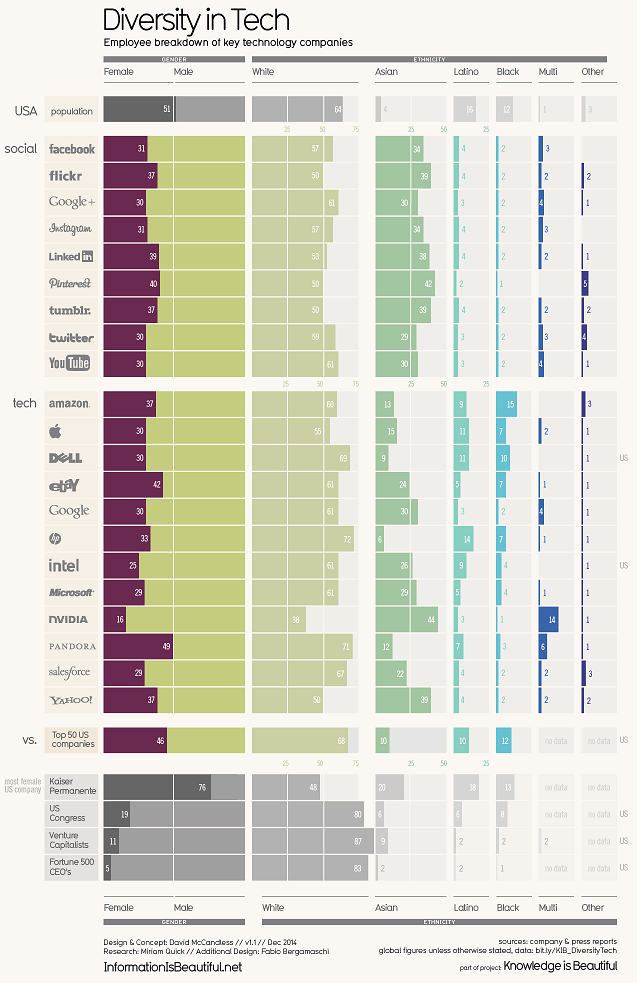This blog post on the digital divide is part of a series where we analyze various topics of national and global interest—education, technology, healthcare, corporate culture, religion, etc.—through the lens of equity and equality, as defined in the introduction to this series.
In the United States, I would argue that there is neither equality or equity in the technology industry. Citizens are not treated the same, nor are they treated without favoritism or bias with respect to access to technology.
To discuss equity and equality in technology, we should first define our terms
Equality requires that we treat people the same, or that people have the same power or status. Equity requires that people experience fairness, justice, and freedom from bias. Equity applies a historical and analytical lens to a situation or outcome and asks: How do we fix, or address, outcome disparities that are the result of favoritism or bias? Equality is leaving the door open for anyone who has the means to approach it; equity is ensuring there is a pathway to that door for those who need it.
By technology, I am referring to access to technology (e.g. internet, broadband, computers, tablets, mobile phones, etc.) and access to technology jobs, (e.g., full stack developer, data scientist, development operations engineer, etc.,). Why is it important that we talk specifically about access to technology and technological jobs?
The U.S. Bureau of Labor Statistics predicts that in 2020 there will be 1.4 million more software development jobs than applicants who can fill them. U.S. data shows that households with higher internet use correlated with (but did not necessarily cause) higher incomes and less income inequality. Moreover, U.S. metropolitan areas with higher broadband adoption boast higher average household incomes and lower income inequality.
In a recent article, Karl Vicks discusses the Digital Divide, and how much of America has no, or very limited access to the internet. This divide is marked by geography, income, race and ethnic background. Geographically, in urban areas just 3 percent of people lack access to broadband, but in rural areas, 35 percent of people have no access. That’s about 22 million Americans.
In terms of socio-economics, a recent Pew Research Center report highlighted persistent inequities in access to basic technologies. They found that nearly half of US households with incomes below $30,000 a year do not have access to high-speed internet at home, while nearly one third do not own a smartphone. This lack of access makes it even harder for poorer families to catch up financially and professionally. Various studies have also highlighted that Hispanics and African Americans use the internet the least of any racial, or ethnic group.
This deficit in access exacerbates a deficit in technology employment. How can one be employed in an industry to which they have no familiarity? For many, phones have become a substitute for home internet or broadband. This reliance on smartphones also means that the less affluent are more likely to use them for tasks traditionally reserved for larger screens. However, as soon as a kid runs out of data, or the library or McDonald’s closes, learning stops. Pew calls this a “homework gap,” a concept referred to in our Equity vs. Equality: Eliminating Opportunity Gaps in Education blog post, where kids simply do not have access to resources at home such as security, shelter, nutrition, the internet, or broadband that they need to complete homework assignments.
Over a few years, a “homework gap,” creates an employment and income gap. In few places is this skewed wealth distribution more visible than in and around Silicon Valley. “The chasm between tech multi-billionaires and the rest of the population in Northern California — where an estimated 31 percent of jobs pay $16 per hour or less and the median income in the U.S. today is about the same as it was in 1995 – is huge.”
So, it is no surprise that the technology industry has a public relations and diversity problem. As the figure below depicts, the technology industry compares favorably only with the US Congress and Fortune 500 CEOs with regards to gender, racial and ethnic diversity. According to a study done by Atlassian, Black and Latinx tech workers combined make up just 5% of the tech workforce and women only 24%.
So, I believe, neither equality nor equity exists with respect to access to technology and access to technology jobs. What are some possible solutions to this “digital divide?”
While it is tempting to name technology as one of the main culprits for the rise in inequality, technology does not cause income disparity, people do. When CEOs and technology executives choose to horde the benefits and rewards of technological innovation as opposed to reinvesting it in people and communities, we have increased inequity.
We should all support programs that give kids from lower-income, and rural, households ample access to connectivity and devices, even if it means direct subsidies to poorer and/or more remote areas. Remember, we said “Equity challenges and acts, “What policies, systems, and practices must be addressed or dismantled in order for everyone to be treated fairly?”
While no effort alone is perfect, the city of Seattle has an excellent definition of digital equity: “Digital equity seeks to ensure all residents and neighborhoods have the information technology capacity needed for civic and cultural participation, employment, lifelong learning, and access to essential services.” The city’s Digital Equity Action Plan identifies goals, strategies, resources and has a vision that is admirable: “We envision Seattle as a city where technology’s opportunities equitably empower all residents and communities – especially those who are historically underserved or underrepresented.”
There are programs such as Girls Who Code and Indeed We Code to increase the exposure of young girls to technology and technological jobs because while tech jobs are among the fastest growing in the country, girls are being left behind. In 1984, 37% of all computer science graduates were women. Today, the number of female computer science graduates is 18%. As I mentioned earlier, by 2020, there will be 1.4 million jobs available in computing related fields. US graduates are on track to fill 29% of those jobs. Women are on track to fill just 3%.
Interestingly, while federal regulators announced steps this month to close the digital divide in rural America, there appears to no added focus on the rural poor and low-income urban areas. Some are even arguing that the Federal Communications Commission is changing its rules to hide America’s digital divide. “FCC chairman Ajit Pai has a theory. He believes that accessing the Internet through a smartphone is just as good as having high-speed Internet access in your house. In fact, he appears to believe this so strongly that he is considering changing his agency’s guidelines so that any place in the U.S. that has sufficient mobile coverage will be considered “connected,” even if people living there have no option to receive broadband access in their homes.”
As citizens, #staywoke, and support genuine efforts to increase equality and equity in technology. As we stated in #StayWoke… Live Inclusively: Equity vs. Equality , “equity begins by asking yourself: Are you getting the things you deserve, and are you willing to stand with and elevate the voices of those who are not.”




















